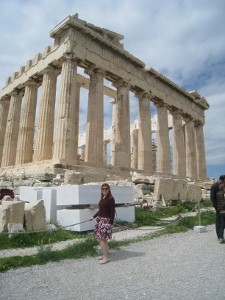
Seize the moment. Spring brings experiences that we wait for all winter. Begin a new chapter by enjoying the cuisine of Greece. The traveler learns the culture, geography, history and traditions not through books or the internet. Cuisine is a place to begin.
Despina Siolas, MD/Ph.D. and her husband, Laurentino Ibarra, seized their moment. They travelled: Athens in one day and the Peloponnese in seven days during Easter 2015. How was Easter 2015 celebrated with middle class Greeks? Tradition, family, Greek Orthodoxy and patriotism are living values. They began a seven-day travel from Nafplio, Mycene, Areopoli, Pylos, Dimitsana and Tripoli in the heartland of “Old Greece” where the Greek Revolution began.
“I wanted to celebrate Easter with my Father’s family,” she said. “People have a positive outlook. They welcome tourism. Hospitality to strangers is unique in Greece. Everyone knows English, even in the smallest village. Laurentino, who does not speak Greek, was able to communicate with everyone in English.” Their visit has cemented Hellenism for the next generation of their family.
They were greeted at Athens airport in April by her father’s s adopted sister, Pitsa Tsakonas, retired senior librarian of the Benaki Museum. She greeted them in fluent English, taking them to their Athens hotel. After a day at the Acropolis and its museum, they enjoyed an evening dinner of homemade Greek cuisine with the Tsakonas family at their Kessariani home.
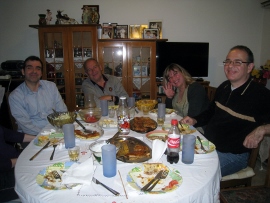
Pitsa Tsakonas prepared tiropites, horiatiki salad (traditional Greek salad), patates (fried potatoes), kima with macaronia (chop meat with pasta), souvlaki and other Greek dishes. They met her daughter, a librarian at the Benaki Museum, retired husband and two adorable grandchildren under the age of five. Hospitality, graciousness and a genuine interest in the American tourists’ welfare shaped the evening’s atmosphere. Cheerfulness and laughter predominated. Cabbage dishes are very popular at this time, served as a lahanosalata. The traditional horiatiki salad with feta, souvlaki, tzatziki, mousaka was served. Pitsa made her own tiropites (cheese pies) from scratch. Every family has their own house wine that is homemade. Pitchers of water and beer were served. The Tsakonas have their house wine made by a relative from the Peloponnese. Dessert was chocolate covered ice cream sandwiches with ice cream cones. “Enjoying food with the Tsakonas family brought us closer together,” Dr.Despina said. “Sharing food with Greek families is part of the Greek travel experience. We came together as a family, communicating through Greek cuisine is a positive interaction.”
The evening ended by visiting “Porto Kagio.” Christos, the owner, greeted everyone warmly with musicians Panteli and others. A wall painting of Mani, traditional Greek folk arts adorned the interior. A view of the life of a middle class Athenian family ended.

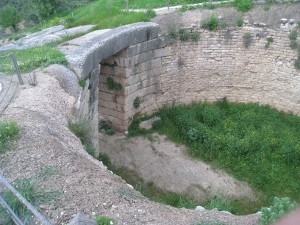
Their new adventure was sightseeing at Mycenae and Nafplio. Sunset in Mycenae was magical. The greenery, sunflower and trees project a different image of the Mycenaean civilization. They arrived at Nafplio, staying at Dafni Pension on April 4 and 5. Their unique experience of Easter Holy Week in the Peloponnese was just the beginning. The comfortable rooms cost 112 euros for two nights. Their sightseeing included Palamidi castle and the 999 steps, Peloponnesian Folklore foundation “V. Papantoniou,” a miniature windmill, St. Spiridon Church, the first pharmacy of Greece, a run along Karathona Beach, walking paths and sights about town. Two dogs were tied opposite a Nafplio restaurant barking at its owner, an unforgettable human interest sight.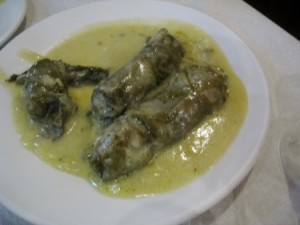
Being at the Taverna Beto was the highlight of their Nafplio culinary experience. “The best Psarosoupa (fish soup) I ever tasted,” said Dr. Despina. “We kept coming back to enjoy the cuisine. This had a lot to do with the warm hospitality of the owners. We were constantly being treated to wine, bear tsipouro and cheese, their graciousness showed the best of Greece’s legendary hospitality. Young musicians in a band played music with everyone dancing. The restaurant was open for a year. We enjoyed gigantes, dolmathes with meat and rice, fried potatoes, okra with potatoes, carrots, souvlaki, tzatziki, grilled peppers, potatoes with lemon and octopus during our stay.
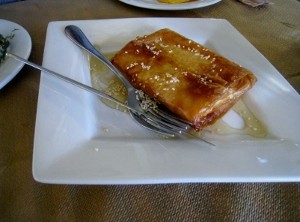
“We learned some interesting facts on grilled shrimp,” explained the tourist. “The head must be kept on to keep the juice. Many were sucking on the shrimp head to get the juice. Seafood was very popular during Easter week. We had squid stuffed with feta, parsley, olive oil, lemon juice with salad. The Folklore museum showed an aristocratic table with crystals, hand cut tablecloths. It looked straight out of a bridal registry from Macys and Bed, Bath and Beyond. A box of traditional koulourakia, vanilla, cinnamon, pistachio and chocolate biscotti and nistisima (Lenten) cookies were a souvenir of Nafplio.
“Laurentino, unknowingly, wore a green shirt that appeared he supported Panathinaikos,” she said. “They kept treating him to wine, beer, tsipouro and cheese. Panathinaikos was popular at this taverna.” Panathinaikos FC is a professional Greek soccer team founded in 1908. It is a successful team in the Greek Super League. Greek hospitality at its best.
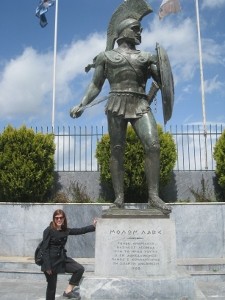
The tourists in their rented car drove to Areopoli, passing Sparta and Mystra, on Holy Monday, April 6. A gigantic statue of king Leonidas greeted them in Sparta. “Both ancient and modern writers have used the Battle of Thermopylae as an example of the power of a patriotic army defending its native soil.” “The defenders’ performance at the Battle of Thermopylae is also used as an example of the advantages of training, equipment and good use of terrain as force multipliers and has become a symbol of courage against overwhelming odds.”
At the Xenia Mystra Café, they enjoyed a spring view of the Laconian countryside with blooming olive trees. Keftedes with cloves, cinnamon and olive oil was one of the aromatic dishes. The old world atmosphere of these restaurants with white tablecloths including the panoramic view gives one a feeling of contentment. Mystra came alive with the look of spring and Mount Taygetos looming largely in the background. “Families lived there up to the 1950’s,” said Dr. Despina. “The Despot (ruler) lived at the highest point. The poorer classes lived outside the tower. Palm Sunday, April 6, was a perfect time for sightseeing: not too hot or cold; no lines of tourists. Visiting the Museum of the Olive and Greek Olive Oil showed the production and history of olive. Their voyage into the heartland of Hellenism continued.
Links:
All photos by Despina Siolas, MD/Ph.D.
http://www.mygreekdish.com/recipe/bougatsa/
Xenia Mystra Restaurant, Pizza-Café, Laconia +30 2731 020500
See all the latest news from Greece and the world at Greekreporter.com. Contact our newsroom to report an update or send your story, photos and videos. Follow GR on Google News and subscribe here to our daily email!



